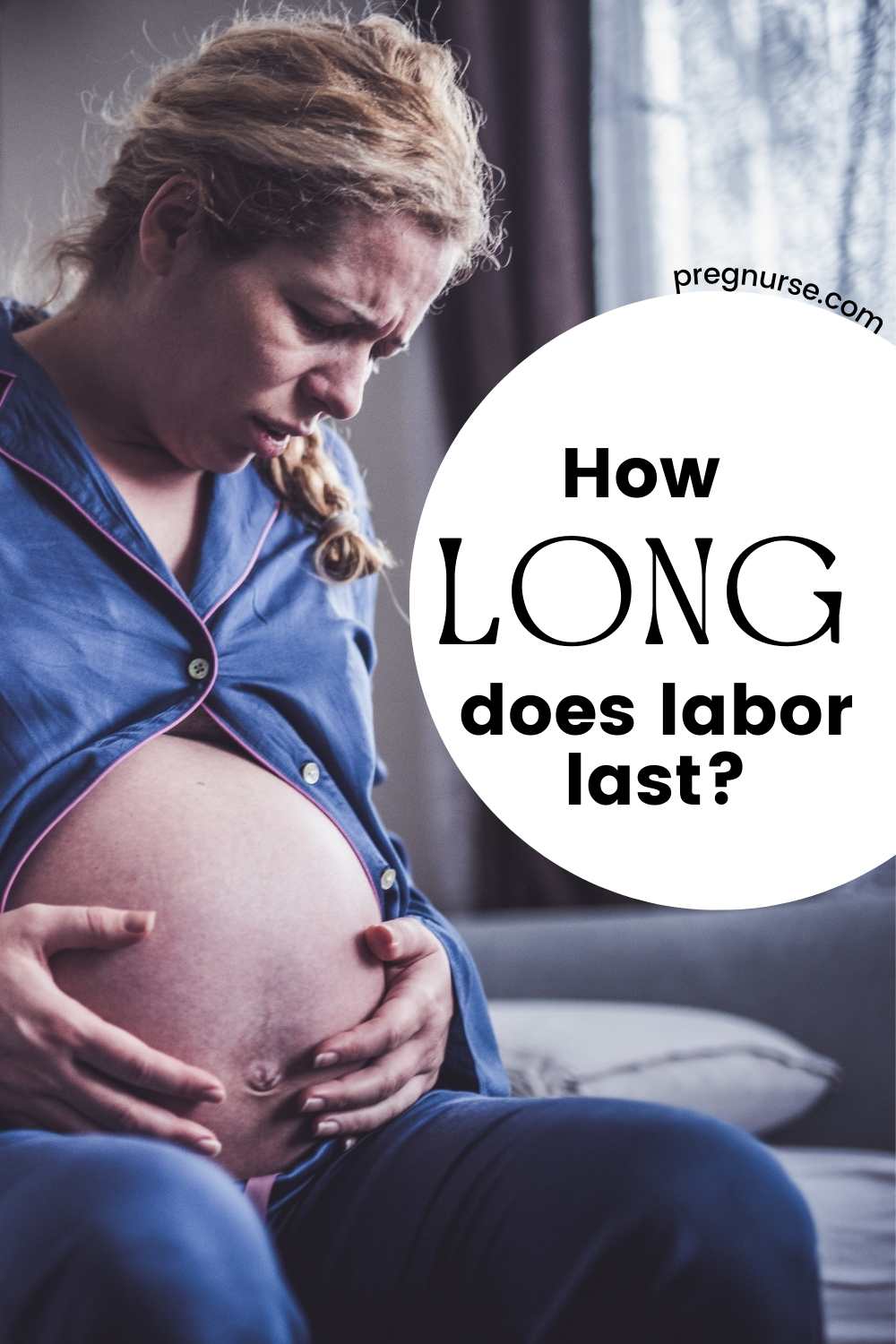👋 I’m so glad YOU are here. Are you looking to also get your partner prepared? This is for BOTH of you. Couples just love it and I know you want to both feel prepared!
How long will your labor last? Labor has four phases (or stages) of labor that you body will move through. While there are textbook cases of how long each stage should last, sometimes your body doesn’t read up on it…
Hi, I’m Hilary — The Pregnancy Nurse 👩⚕️. I have been a nurse since 1997 and I have 20 years of OB nursing experience, I am also the curly head behind Pulling Curls and The Online Prenatal Class for Couples. 🩺 I’ve seen thousands of labors, and I can help you understand what to expect as well.
I also have a youtube video that explains all of this with my crocheted pelvis, don’t miss it {and SUBSCRIBE} 🙂
Stages of Labor
There are four stages of labor (you can click on each one to be taken to a section just on that phase):
- Latent Labor
- Active Labor
- Pushing
- Delivery of placenta
Stages vs Phases
The words are used inter-changably with providers. Some call them stages, some call them phases. Either way — this is your roadmap as to what to expect during your delivery.
And if you’re wondering WHAT THE HECK you got yourself into… do yourself a favor and join me in here. In just a few minutes I can get you prepared on what to watch for, and what you can do in early labor to keep things going (plus, when to know when you should call or go into the hospital).
Why does this matter?
Honestly, it doesn’t. We don’t chart when each one happens. Like I said above — it is just a roadmap for you to know what to expect (which can be REALLY helpful for first-time moms). In the hospital you might hear someone on your health care team say “she’s in active labor” and that’s about as close as we get into these stages. We know the roadmap because we’ve seen it thousands of time. This just helps you know how labor will likely progress.
1 – Latent Stage of Labor
The latent stage of labor (the first stage of labor) is most often the longest and most confusing part of labor. Families aren’t sure when they progress to the next phase of labor, and should head into the hosptial.
Some also call this early labor.
BTW, I give all of my best tips in The Online Prenatal Class for Couples about when to head into the hospital.
The latent phase of labor starts with mild contractions and ends when your cervix is 4-6 cm (the jury is still out on when this phase “ends” according to the professional organizations).
In most cases with a healthy mom and baby, moms can stay at home during this phase and enjoy the comforts and autonomy therein.
Other symptoms & signs of labor:
- pain in your lower back
- may have some bleeding (called bloody show) — if it is at ALL Worrisome please call your provider
- Nausea even Vomiting
- Diarrhea
- Generalized malaise (just not feeling great)
- you lose your mucus plug
Of course, similar symptoms can happen that don’t turn into labor. Contractions that aren’t progressing you into labor are often called false labor or Braxton Hicks Contractions. You can always call your health care provider if you’re not sure what’s going on.

What happens during the latent phase?
During this phase your uterus is contracting, often irregular contractions and engaging the baby’s head into your pelvis. Contractions may come and go and many women describe this phase as lasting days.
Often it progresses into just not feeling well (overall achy and annoyed) into timed contractions that put you into the next phase of labor.
I have a whole post about the latent stage of labor, and what you can do to hurry it along .
How long does the latent phase last?
Who. knows. As I said before, it’s never quite clear when this stage “begins” which means it’s hard to know how long it will be.
It is also not totally clear when this stage ends — other than your cervix starting to open at a good pace (around 1 cm/hour). BTW, if you’re looking for information on what all those vaginal exams mean, my sister site has a post on vaginal exams in labor (with a video).
My best tip is to make sure that you’re moving frequently in this phase. Many people find a comfortable position and stay in for hours. I would recommend moving frequently (which is why I have labor movement cards in here) when you are asleep. Different positions really helps baby find their best way out.
It is also a great time to start some of your relaxation techniques that you’ve practiced.
During this phase, you will likely want to start packing your hospital bag:
2 – Active Stage of Labor
The active stage of labor (the second stage of labor) begins when your cervix starts opening at a more “standard pace” (normally this is around 1 centimeter/hour.
The doctors define this as start between 4-6 cm. The problem is that some women are at home when they are 4 cm — and are often that for quite a few days, so just because your cervix is 4 cm, it doesn’t mean you’re in labor.
I am seeing most physicians think of this as starting at 6 cm, but if you’re actively contracting every 2-4 minutes, and past 4 cm they might think of you in active labor (or in “true labor”).
If you’re keeping score, this phase just really depends on your providers.
But, it ends at 10 cm — so that is a solid recommendation. Unless, of course, the baby is still high and they would prefer you labor down which may delay the 3rd stage of labor.
Note: “Laboring Down” means you rest as your body and uterus bring the baby’s head into the birth canal without you pushing. It is often used with women who could use some rest and have an epidural, or when the healthcare provider has other issues to attend to at that time.
What happens during the active phase?
Your baby’s head is engaged in the pelvis and is starting to open the cervix more. It will likely move into the pelvis and more towards the baby exit area due to contractions are regular intervals.
This is often when people seek pain relief (often epidural anesthesia), or go to the hospital or birth center.
Think of the cervix as a tight sweater, and your head is pushing against it. I thins out and opens up as your head passes through.
How long does the active phase of labor last?
The textbooks say 1 centimeter/hour. I find that the latent phase of labor centimeters happen much slower, and the last centimeters are much quicker (think of the head and the tight sweater analogy — it would be slower as your head stretches it initially, and then faster as it comes through all the way).
So, it normally takes 4-6 hours. But, every body is different, and some things may make it happen faster, and some might make it slower. Also, it can be really hard to pinpoint the “onset of labor” as some people might call it “labor’ and some might just feel “crappy” (and it’s all your body prepping to have the baby).
And that is OK.
Sometimes doctors order pitocin to speed up labor if you aren’t progressing the 1 cm per hour, but make sure you get informed consent on that additional medication in labor.
This stage ends when you start pushing.
Pro Tip: Some people get these stages mixed-up with other things people talk about like “transition” — this is just a feeling women get as their body is almost ready to push. So many words to keep straight, right?
3 – Pushing Stage of Labor
Pushing (the third stage of labor) is where you use your lungs and diaphragm to push against the baby as it comes out.
An analogy would be when you feel like you have a bowel movement in your rectum. You then push it the rest of the way out (your body pushed it all through your intestines, and you only have to push at the very end).
What happens during the pushing phase of labor?
Your healthcare team will instruct you on how to push, and you begin pushing.
Some women with an epidural take a few tries to get it right as they don’t feel the same as they did without it. The epidural can also be decreased so you can have more sensation if that helps.
How long does pushing normally last?
I have a whole post on how long pushing usually lasts. But, the cliff notes version is this:
- First births (vaginal) — average pushing time is 2 hours
- 2nd and subsequent vaginal deliveries — pushing time is normally less (often by a lot)
Many women push less than 10 times after their first baby as those tissues have stretched and baby comes out much easeier.
However, if baby is larger than his or her brother/sister before them, that can take additional time for all that stretching.
This stage ends at the birth of your baby or when the umbilical cord is clamped.
4 – Delivery of the Placenta Stage of Labor
The Placenta is the organ that fed your baby through its entire gestation. Once baby is born, it is no longer needed and the 4th stage of labor happens as it comes out.
This is normally the quickest stage of labor. Horray!
What happens during the placenta delivery?
You’ll be holding and loving your baby, as your provider waits patiently (we hope) for the placenta to deliver.
They may also be checking to see if you need any stitches or any other assistance by them.
Before the placenta comes off the uterus, there is often a gush of blood and you will likely feel some cramping.
There can be issues in this phase where the placenta does not want to come off the uterine wall. There can also be issues with bleeding during this phase, so it is important that you have a skilled provider at your bedside who is trained in how to deliver the placenta.
How long does it take to deliver the placenta?
Normally around 5-30 minutes (with more people having it at 5 minutes).
Sometimes doctors tug at it to get it to come, sometimes they’re patient and let it come on their own.
Stages of Labor FAQ’s
How does this matter in a cesarean delivery
If you have a planned cesarean, it is not likely that you will go in labor. However, if you’re laboring and then MOVE to a cesarean, your labor will follow a similar plan until the surgery.
If I have painful contractions does that mean that I’m in active labor?
No, Braxton Hicks contractions can still be very painful. It doesn’t always mean you’re going into “active labor”
That’s your four phases or stages of labor. Hopefully it gave you an idea of what to expect and how your labor will likely progress.
Birth can seem SO complicated, but a true expert can really simplify it for you. That’s what we do in the Online Prenatal Class for Couples.
Specific to the stages of labor
- A chapter on contractions, how to know what they are and count them.
- How to know if you’re in labor and when to go to the hospital
- The entire admission process and what to expect at the hospital
- What to expect at delivery (and how to push)
- What to expect following delivery with both mom and baby
And obviously, it progresses more from there. I want families to be confident from birth to bassinet. So many find that they are.
If you’re not ready for the full class — I do offer a free beginning prenatal class that you might be interested in. It talks about 3rd trimester testing and what to come into the hospital for. You can sign up below, or learn more here.








 37 Weeks Pregnant & Having Period Pains? What it means from a labor nurse
37 Weeks Pregnant & Having Period Pains? What it means from a labor nurse

[…] time to take effect as you’re being “hit” by giant waves of pain. This is why the stage of labour you’re in can be really important to know before you place the epidural to help you with the […]